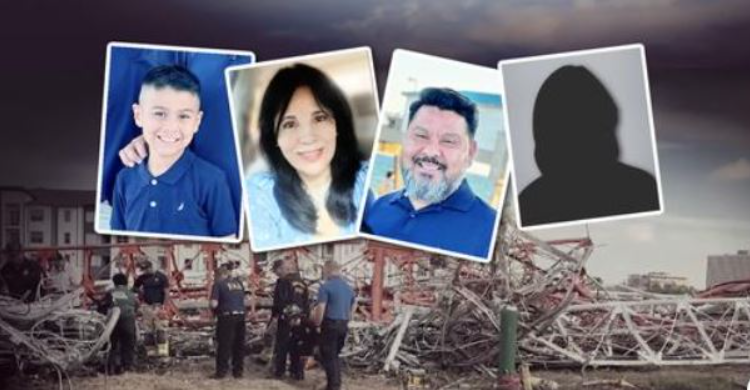The names of the four individuals who lost their lives in a devastating helicopter crash in Houston’s East End have been officially released, providing a sense of clarity to the families and the broader community grappling with the tragedy. The crash, which occurred on Sunday night, involved a sightseeing helicopter operated by National Helicopter Solutions and has since drawn national attention due to the shocking circumstances surrounding the event.
On Thursday, authorities, including the Medical Examiner’s Office, publicly identified the victims. Among them was Cesar Lerma, whose family confirmed he was one of the passengers aboard the ill-fated flight. Other victims included pilot Samantha Grandbouche, passengers Julio Lerma and Dylon Lerma—relatives of Cesar—and a fourth passenger, Marie Alonso.
Preliminary findings from the Medical Examiner’s Office offered a grim picture of the event. Pilot Grandbouche died from multiple blunt force injuries, while the passengers succumbed to a combination of blunt force trauma and thermal burns, highlighting the violent and destructive nature of the crash. The extent of the injuries has underscored the severity of the accident and the challenges responders faced in the aftermath.
Houston Police Chief Noe Diaz gave a detailed account of the helicopter’s ill-fated flight. The helicopter, a Robinson R44, took off from Ellington Field on a sightseeing tour before crashing into a radio tower in the East End of Houston. According to flight data from FlightAware, the helicopter was traveling at a speed of 108 miles per hour at an altitude of 600 feet when it struck the tower. The collision was captured by footage obtained by KPRC 2, which showed the harrowing moment of impact and the subsequent explosion.
The crash not only led to the complete destruction of the helicopter but also caused significant damage to the radio tower. In a fortunate turn of events, no individuals on the ground were injured despite the tower’s collapse, and no other buildings or structures in the area sustained damage.
Following the crash, a fire broke out, burning between 100 and 200 yards of nearby grass. Firefighters quickly responded to the scene, and the flames were brought under control without further complications. However, the aftermath left a significant impact on the scene, with charred wreckage serving as a stark reminder of the tragic event.
The crash has prompted a comprehensive investigation involving multiple agencies, including the Federal Aviation Administration (FAA), the National Transportation Safety Board (NTSB), and local law enforcement. Their primary objective is to determine the cause of the crash, focusing on why the helicopter veered off course and collided with the tower.
Investigators will be analyzing flight data, conducting interviews with individuals familiar with the helicopter’s operations, and reviewing maintenance records to uncover any technical or human factors that may have contributed to the crash. The process is expected to be thorough and methodical, taking time as officials piece together the sequence of events leading up to the tragedy.
The helicopter crash has left a deep emotional scar on the Houston community. Families of the victims are grappling with profound grief, while the wider community mourns the sudden loss of life in such a devastating manner. As the investigation continues, there is hope that the findings will provide a measure of closure to those affected.
The tragedy has also raised concerns about the safety of aerial sightseeing tours. While incidents involving helicopters are relatively rare, the risks associated with low-altitude flights over urban areas have come into sharper focus. According to the NTSB’s records, while commercial air travel is among the safest modes of transport, helicopter accidents—particularly in non-commercial settings like sightseeing tours—account for a significant portion of aviation-related fatalities in the U.S. each year.
As authorities work to complete their investigation, the families of the victims and the Houston community await answers. For now, the focus remains on understanding the cause of the crash, improving aviation safety, and ensuring that the lessons learned from this tragedy help prevent future incidents. The lives lost—Cesar Lerma, Samantha Grandbouche, Julio Lerma, Dylon Lerma, and Marie Alonso—will not be forgotten, and the community stands united in grief, hoping that clarity will emerge from this heartbreaking event.
In the wake of this incident, the conversation around aerial tourism and safety standards is likely to intensify. While the FAA has stringent regulations in place, the inherent risks associated with helicopter flights, particularly in densely populated areas, may lead to renewed scrutiny and calls for stronger oversight in the industry.



